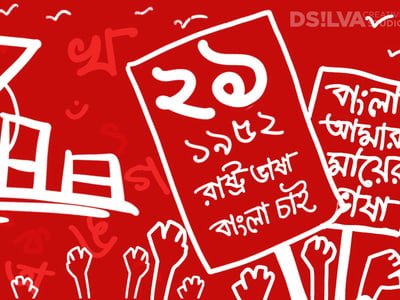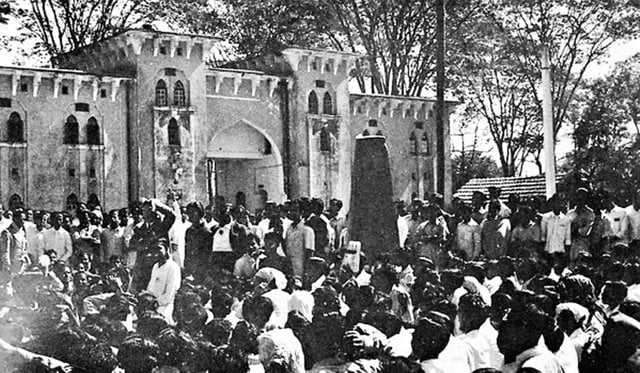The recent protests that have come to light since the Citizenship Amendment Act has been passed have instigated me to think about our country, its history, its diversity and its politics, especially since independence. While some political parties do want to divide its citizens through identities of religion and caste thereby homogenising the “culture” of India, categories of identity, which might be vested with powers of division, often end up integrating people in ways that are not outwardly visible. Language is one such medium through which communities across religions, countries, castes, classes, genders and ethnicities can find commonalities, either through their present active usage, or through their common historical roots. On 21st of February each year, the spirit of unity in diversity is celebrated through the International Mother Language Day across the world, since UNESCO declared the same on 17th November 1999. However, its formal recognition only happened in the year 2002.

The obvious feminist criticism of the use of such gender specific term “mother” language or “mother” tongue would be the patriarchal subjugation insidiously placed within it. Sources inform, that the etymology of the term “mother” tongue and consequently “mother” language is due to the care work mothers put in or are expected to put in, in the process of child rearing. While this could be an acknowledgement of the unpaid care work women do as primary caregivers, it could also act as a metaphor to glorify their care work, indirectly imposing the burden of teaching native languages to children. However, keeping in mind the feminist critique, we still should try to understand why the International Mother Language Day is crucial and a reminder to preserve diversity.
Although the day does have a tragic past to be commemorated, its intentions have travelled across space and time to acquire new meanings of peace and solidarity. The history of the day can be traced back to Bangladesh and its Bengali Language Movement which was organised to fight for linguistic and cultural rights. The day has a bloody past of its own, where students who were protesting were brutally murdered by state forces like the police. This day is observed not simply to remember their martyrship but also to remind everyone about the heterogeneity of cultures and the need to conserve their differences.
History
Bangladesh was a part of present India till 1947. It was ruled by the exploitative colonial government and later was subjected to partitioning itself on grounds of difference in religion. The present Pakistan was called ‘West Pakistan’ and Bangladesh was called ‘East Pakistan’. Post the first partition in 1947 however, Bangladesh was still dominated and governed mostly by the Western parts of the new state of Pakistan. Decisions about the state and its authorities were all made by the West Pakistani officials.

Although the Partition of 1947 was arbitrarily made on grounds of religious difference (Hindu-Muslim), the cultural, linguistic and ethnic complexities continued to prevail in both the West and East Pakistan. And hence, Bangladesh, then East Pakistan, could not simply submit to the homogenising techniques of the West Pakistan authority. One of the major factors that distinguished the two were their local languages. While the Western part of Pakistan used Urdu, East Pakistan used Bangla or Bengali as their language for communication.
ON 21ST FEBRUARY 1952, THE PROTESTS REACHED ITS PEAK AND THE THEN GOVERNMENT OF PAKISTAN ENFORCED MEASURES THAT PROHIBITED THE GATHERING OF MORE THAN 3 PEOPLE, QUITE LIKE SECTION 144 IN INDIA WHICH WAS REPEATEDLY IMPOSED IN THE RECENT ANTI CAA-NRC-NPR PROTESTS.
The differences in the languages were respected until the government, dominated by the West Pakistani officials decided in an education summit in 1947, declared that Urdu be the only official language to be taught and used in educational institutions, like schools. Bangla or Bengali was also removed from the official currency and stamps and as a subject to be taught in schools in the newly formed nation state of Pakistan.
The formation of a nation-state does demand homogeneity in the form of “National Language”, “National Religion”, “National Bird, City etc.” in order to establish their “unity” as a country. However, modern day nations, which have a complex and diverse past cannot be unified coercively through such mandates. There has always been resistance against such attempts to erase histories. For example, in the case of India, there have been multiple attempts to coerce Hindi as a language medium, especially in the southern and eastern parts of the country, which have various native languages of their own.
Resistance
The efforts of making Urdu the dominant language for both parts of Pakistan met with serious forms of resistance. These Bangla speaking students and other individuals protested against such linguistic policies for the next 5 years which gave rise to the Bengali Language Movement. The student led organisations in East Pakistan were one of the most prominent voices of protest to preserve their language and the cultural meanings attached to it. More than half a century later, we still find student led organisations and communities of individuals actively participate in challenging the fascist motivations of governments, not just in this part of the world, but across the globe.
On 21st February (now declared as the International Mother Language Day) 1952, the protests reached its peak and the then government of Pakistan enforced measures that prohibited the gathering of more than 3 people, quite like Section 144 in India which was repeatedly imposed in the recent Anti CAA-NRC-NPR protests. However, despite such regulations, students from University of Dhaka, which is now the capital city of Bangladesh, defied such restrictions and gathered together to protest the Urdu language imposition on them.

The police present at the site fired tear gas at the students and made several arrests. The protests then moved to East Bengal Legislative Assembly, where the protesters wanted to demonstrate their protests inside the building. However, the police retaliated brutally and shot fires at the students and killed many of them. Once only deemed as a “cultural movement” was steered progressively towards a political movement meant to bring independence for Bangladesh.
Also read: Language Privilege In India Isn’t As Straightforward As You Think
Looking at the determination and grit of the students, people from all fields joined the movement which lasted till 1971, the year Bangladesh became shadheen, independent. The independence or the creation of a new nation state did not imply that diversity cannot live with each other, but rather it was a decision that was made in order to safeguard linguistic diversity which was not given by West Pakistani administration. UN reports that, “At least 43% of the estimated 6000 languages spoken in the world are endangered. Only a few hundred languages have genuinely been given a place in education systems and the public domain, and less than a hundred are used in the digital world.”
languages cannot be divided on communal lines; not simply because people from different faith speak similar languages, but also because of the inherent diversity from which they originated. Over space and time, languages themselves have interacted with one another to attain new forms and dialects which cannot be simply segregated into categories.
Religion was not powerful enough to unify these culturally diverse groups of people. This sort of resistance shows that even though, in present day India, the Hindutva forces might believe in a country that is unified in terms of their Hindu religion, such initiatives at the end of the day meet with challenges not simply of secularism but also of cultural diversity and difference. Hindutva can never succeed in creating a Hindu country, because the citizens have different histories as well as politics, which run beyond the antagonistic binary of Hindu versus Muslim.
International ‘Mother’ Language Day Today
If the above description of state and police violence was narrated without a context, it must have been difficult for a lot of us to recognise that such incidents are from the past, and not contemporary times. However, given the despicable situation of India, the past seems to come alive. India, once a country that took pride in the diversity it houses, has now become a project for diluting such differences by discriminating against people who do not conform to a particular religious identity.
However, languages cannot be divided on communal lines; not simply because people from different faith speak similar languages, but also because of the inherent diversity from which they originated. Over space and time, languages themselves have interacted with one another to attain new forms and dialects which cannot be simply segregated into categories.

Processes like globalisation have benefitted diversity to project themselves on international platforms, but on the other side of the spectrum, they have also curbed diversity by making certain language requirements mandatory for employment and education. This has also happened in national, regional and local ways, whereby children who do not have a grasp on the “standard” languages of formal expression, have had difficulties in getting jobs and education.
Also read: The Violence Of Language: A Feminist Take On The ‘Culture’ Of Abuses
Despite such tremendous opposition to diversity by homogenising forces, the fight to preserve languages by speaking, writing and reading needs dire encouragement. Most languages are disappearing or are threatened to disappear. If we give in to such forces of standardising, then we will also be complicit in losing out on the histories and cultures of our being. The only one remaining will be the dominating forces with their own tweaked versions of socio-cultural evolution, which most definitely will marginalise the subordinated people of the world.
Featured Image Source: Dribbble
About the author(s)
Pragya is a Master's Graduate in Sociology from Jawaharlal Nehru University. She works as the content editor at Feminism In India. She is also a ramen enthusiast, a hummus mother, a postcard hoarder and a wannabe cat lady. She still prefers writing on her notebooks, rather than on her laptop, but her job demands her to do just the opposite. Her favourite season is spring, and her alter ego is that of Mrs. Dalloway who said, "She would buy the flowers herself", in case no man ever buys her any!




